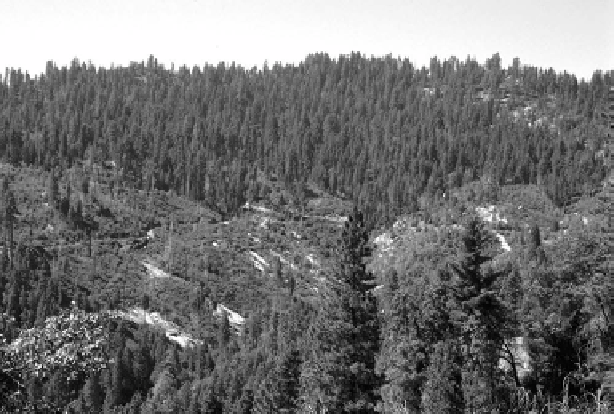Agriculture Reference
In-Depth Information
Fig. 9.10
Transition from crown fire chaparral to surface fire regime of mixed conifer forest in
the Sierra Nevada Range of California (Photo by Jon Keeley.)
under a regime of severe disturbance resprouting would be selected against
when disturbance frequency is low; however, as a general prediction, the
nearly ubiquitous distribution of resprouting in woody dicots from most
environments contradicts that conclusion. Resprouting is common in non-
fire-prone or fire-resistant communities, although postfire seeding is not (e.g.
Gill
1997
; Campbell & Clarke
2006
). For shrublands, the Bellingham &
Sparrow model predicts that non-resprouting obligate seeders will dominate
under very low disturbance frequency and gradually be replaced by resprou-
ters as frequency increases. Indeed, under very short fire return intervals non-
resprouting species will be eliminated whenever the fire return interval exceeds
the time to reproductive maturity (Zedler
et al.
1983
; Nieuwenhuis
1987
;
Bradstock
1990
; Pausas
2001
). However, long intervals between fires (low fire
frequency) will have very different selective values dependent on whether seed
storage is in the soil or in the canopy. Obligate seeders with hard-seeded soil-
stored seedbanks could be favored by long fire intervals (Keeley
1977
) but
such a regime would select against obligate seeders with canopy seed storage
(Lamont
et al.
1991
).
The primary limitation to the Bellingham & Sparrow (
2000
) model is that it
considers resprouting and seeding as continuous functions of fire frequency or fire
severity, and it ignores other components of the fire regime, in particular fuel
structure and its control on fuel consumption. Fire frequency has radically different
impacts on resprouting success in shrublands under crown fire regimes than in forests
with surface fire regimes and this problem is not solved by scaling against productiv-
ity as they have done. For example, the sharp boundary between a shrubland and a
forest (
Fig. 9.10
) represents a tipping point in which the selective factors for life

